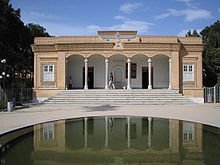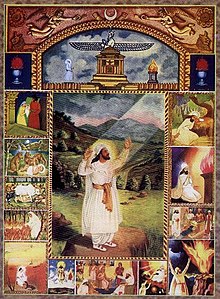Zoroaster
![]()
Zoroaster is a redirect to this article. For the oil tanker, see Zoroaster (ship).
![]()
This article describes the Iranian founder of religion. For other meanings, see Zarathustra (disambiguation).
Zarathustra (Avestan Zaraθuštra) or Zoroaster (Greek Ζωροάστρης Zōroástrēs), also called Zarathustra Spitama, was an Iranian priest (zaotar) and philosopher. He taught in the second or first millennium BC, in a north-eastern Iranian language that later became known as Avestic after the Avesta, and helped Zoroastrianism, named after him, to its later breakthrough as a Persian-Medic or Iranian religion, which is why he is also called, for example, "founder of Zoroastrianism", "founder of religion", or "reformer". The followers of Zoroastrianism are called Zoroastrians or Zarathustrians. The followers in today's India and Pakistan include in particular the ethno-religious groups of the Parsis and partly the Irani.
The name Zaraθuštra probably means "owner of valuable camels" (the interpretation of the forelimb zarat- as "old, precious, golden" is disputed; the hindlimb of this compound is generally identified with Avestic -uštra- "camel"). Other name forms include: Middle Persian Zardusht, Persian زَردُشت, DMG Zardošt, also زَرتُشت, DMG Zartošt, Pashto زردښت Zardaxt, Kurdish Zerdeşt, Ancient Greek Ζωροάστηρ Zōroástēr / Ζωροάστρης Zōroástrēs.
The ancient Greeks saw in him a sage; in the eyes of French philosophers, including Voltaire, he was a mediator in matters of religious faith. Similarly diverse are the statements in Oriental studies, which so far make a final clarification of Zarathustra's work impossible. It remains unclear in which social and geographical environment he worked, whose ideas he took up or on which foundations he built his teachings. He is considered by some to be the founder of the first monotheistic religion based on the belief in Ahura Mazda.
The chronological classifications made so far by the historians are based on various sources, from whose interpretation partly theories and theses about the work of Zarathustra were developed, which ignore the few archaeological indications. For example, Ammianus Marcellinus was the first to establish a connection to the Achaemenids via Wischtaspa (father of Darius I). However, the fact that Wischtaspa was a common name for many centuries precludes an exact chronological assignment.

Zoroastrian fire temple in Yazd, before 2006
Origin
According to legend, Zarathustra's mother came from Raga. In modern research there is disagreement about Zarathustra's birthplace and his place of activity, which is why several possibilities are controversially discussed. By Touraj Daryaee (USA) Balkh in the north of today's Afghanistan is given as birthplace.
Northeast Iran and Sistan
Hints in the Avesta are interpreted in the form that Zarathustra could have stayed in Sistan (in today's border area of Iran and Afghanistan). Sistan played an important role in the Persian world of faith, which, however, cannot be causally attributed to Zarathustra. Only in post-Zarathustrian times the attempt to establish connections and commonalities took place, because due to the isolated desert location the holy mountain Kuh-e Hadsche at Lake Hamun made the place Sistan the Mecca of the Zoroastrian followers.
Through many periods of Sistan's history, the oasis led a life of its own because of its difficult-to-reach location and developed completely autonomously, detached from the respective religious currents. Because of Sistan's religious appeal, it is therefore probable to a small degree that Zoroaster may have temporarily worshipped here, although evidence of early Ahuramazda belief in this region is lacking. However, because of the documented early Iranian migration from east to west, short-term points of contact may have existed.
Media and Azerbaijan
In the regions of the Median confederation, the originally Persian state territory of Parsua is documented in Assyrian inscriptions as early as around 1000 BC. In the following period, it is mentioned increasingly frequently under the name of Anshan. Archaeological investigations confirm decisive political and social upheavals for the same period in the territory of present-day Azerbaijan. Among other things, Azerbaijan was the destination of east-west migration, in the course of which East Iranian nomads migrated alongside Indian tribes. The archaeological evidence shows that the indigenous culture intermingled with that of the new immigrants.
In connection with the settling down and the merging of the nomadic culture with the agricultural culture, there are also clear indications of the development of a new religion. In the 8th century B.C. the Median name Mazda appeared for the first time, which only lacked the addition Ahura. Zarathustra also never mentioned the name Ahuramazda in his teachings, but at first only Mazda or Ahura. It should be reserved to the Achaemenids to unite both names to Ahuramazda only in 522 B.C. under Darius I.
The name component Wischtaspa (horse) refers to the horse breeding areas characteristic of Media and Azerbaijan, from which the Assyrians obtained their horses. Zarathustra called among others the Median priestly caste Magawan his followers, whose heartland was without doubt Azerbaijan.
Lifetime
There are different more or less convincing opinions about the dating of Zarathustra's lifetime:
- Zarathustra lived around 600 B.C. This determination is based on the tradition of the Islamic scholar Biruni, who, according to Sassanid tradition, placed the time of Zarathustra's calling at 258 years before Alexander. Wiesehöfer, Lommel, Altheim and Walther Hinz rely on this. According to them Zarathustra lived from 630 B.C. to 553 B.C.. Hinz assumes a meeting of Zarathustra and Kyros II (585-530 B.C.), who did not adopt his teachings, but showed himself tolerant towards all religions.
- Confirmation of the worship of Ahura Mazda, the supreme god named by Zarathustra, was not proved certain until the reign of Darius I (* 549 BC; † 486 BC). This prompted Hertel and Herzfeld, as reported by Ammianus Marcellinus, to identify the prince Vistaspa, who patronized Zoroaster, as Hystaspes, the father of Darius I, which would have made Zoroaster the elder contemporary of the son.
- The Orientalist Thomas Hyde points out that the Syrian scholar Abū l-Faradsch writes in his "Dynastic History" that Zoroaster was a disciple of the exiled Jew Daniel in Babylon. According to biblical tradition, the latter belonged to the part of the population of Judah that Nebuchadnezzar II sent into the Babylonian Captivity, which lasted from 598 to 539 BC.
- Zarathustra had lived around 1000 BC. This is assumed by Eilers and Stausberg, among others. This dating presupposes the appearance of Zarathustra in the area around Bactria.
- Such a middle dating would hardly be in accordance with the appearance of the Iranian tribes of the Medes and Persians, which is regarded as certain. Also Zarathustra is supposed to have been already active as priest or magician before his "calling experience". For these reasons Frye determined the work of Zarathustra for the time around 800 BC.
- Zarathustra lived around 1800 BC, more precisely: was born in 1768 BC. This view is held in particular by Iranian scholars (Behrūz, Derakhshani) and Mary Boyce. In the context of the settlement of Persia Zarathustra's appearance is to be placed already with the first wave of immigration.
- The mention of the god Mithra in the Gathas thus poses dating problems, since secure references to this god are only available at a later time and its cult was condemned by Zarathustra in the Avesta.
Besides different scientific methods and arguments, ideological motives also play a role in this dispute. Zarathustrians celebrate his birthday on 26 March.

Zarathustra, birth to enlightenment
Search within the encyclopedia